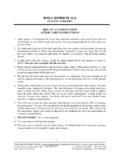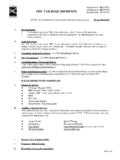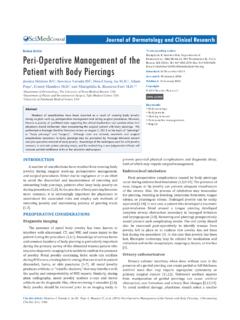Transcription of the No-Touch Technique in Saline Breast Aesthetic Plastic ...
1 An Easy and Cost-Effective Method to Performthe No-Touch Technique in Saline BreastAugmentationShuhao Zhang, MD; and Nadia P. Blanchet, MDAccepted for publication January 12, 2015; online publish-ahead-of-print June 11, No-Touch Technique of Breast implant insertion is a well-described method to minimize skin contamination, which isthought to be a significant cause of capsular contractureafter implant-based Breast augmentation . Studies have de-tected bacterial growth in 76% to 89% of contracted im-plants,1,2and the presence of biofilms has also been shownto increase the risk of capsular contracture in a original No-Touch Technique was described byMladick in 1993. In the original iteration, several assistantsheld retractors to keep the skin incision open and avoid skincontact while the implant was , we describethe simple modification of a disposable, sterile light-handleglove into a sleeve for insertion of a Saline our experience, a Devon Lite Glove surgical lighthandle glove (Covidien, Masfield, MA) can be easily con-verted into a sleeve by cutting off the closed, narrow end ofthe glove (Figure1).
2 The narrow end of the light handlecover easilyfits in the small inframammary incision. Theinside of the light handle is moistened with sterile Saline orwater-soluble lubricant, and a folded, deflated Saline pros-thesisfits easily into the sleeve (Figure2). After making theinframammary incision and dissecting the Breast pocket,the surgeon can place the narrow end of the sleeve into thepocket and insert a Saline implant without skin contact(Figure3). The sleeve is then easily retrieved from thepocket. (A video demonstrating the Technique is )The senior author has performed this Technique in 64patients since January 2012. To date, there has been no in-cidence of capsular contracture. The light handle is pack-aged and pre-sterilized for use in the operating room by themanufacturer, and according to the manufacturer (J Porter,e-mail communication, January 2015), is made of high-density polyethylenefilm, is latex-free, and contains noother chemicals.
3 High-density polyethylene is a safe materialused in a variety of medical implants. It does not interactwith the implant or the patient s tissue. Because the salineimplant is deflated prior to insertion, there is no outsidecompressive force to damage the implant as it is passedthrough the sleeve. The cut end of the sleeve is not sharpand thus does not damage the implant. There has been noincidence of implant rupture since adoption of this tech-nique. Finally, because this Technique causes no physicalinjury to the implant, it does not void the manufacturer swarranty on the concept of employing a conduit for insertion of abreast prosthesis had been described as early as 1984 whenDolsky utlilzed polyethylene tubing for insertion of theM me relationship between bacterial con-tamination and capsular contracture led to the develop-ment of the No-Touch Technique to minimize skin et al found that compared with digital insertion, theuse of the Keller Funnel (Keller Medical, Stuart, FL)
4 Signifi-cantly decreases skin contact and bacterial contaminationof smooth-gel implants in a cadaver et al havepublished the application of a modified Toomey syringecasing for insertion of Saline , this re-quired cutting the casing with a saw and burning it with abutane torch, thus never became common disposable,flexible Devon surgical light handleglove costs less than $2 and is easily available from the this modification of the product is ideal forsaline implants, it will not accommodate a gel we still employ the Keller Funnel to perform breastFrom the Division of Plastic and Reconstructive Surgery, Departmentof Surgery, Virginia Commonwealth University, Richmond, VA, Author:Dr Nadia P. Blanchet, Clinical Assistant Professor of Plastic Surgery,Department of Surgery, Virginia Commonwealth University, 9210 Forest Hill Ave, Richmond, VA 23235, : to the EditorAesthetic Surgery Journal2015, Vol 35(6) NP176 NP178 2015 The American Society forAesthetic Plastic Surgery, and with gel implants.
5 One critique of this reportmight be the short length of time we have performed thistechnique, precluding sufficient follow-up to determine long-term capsular contracture rates. Though a future study withlonger follow-up may be a worthwhile undertaking, paststudies have shown that one would expect to see a majorityof Baker Grade III-IV capsular contracture within 2 years ofaugmentation modification we have de-scribed above allows the surgeon to perform Breast augmen-tation with a Saline prosthesis using the No-Touch techniquein an easy, economic MaterialThis article contains supplementary material located onlineat authors declared no potential conflicts of interest withrespect to the research, authorship, and publication of this authors received nofinancial support for the research,authorship, and publication of this Dobke MK, Svahn JK, Vastine VL, Landon BN, Stein PC,Parsons CL.
6 Characterization of microbial presence at thesurface of silicone mammary implants. Ann Plast ;34 Pajkos A, Deva AK, Vickery K, Cope C, Chang L, Cossart of subclinical infection in significant breastimplant capsules. Plast Reconstr Surg. 2003;111 of the Saline prosthesis through the sleeve into the the narrow end of the light handle of the prosthesis into the light handle afterthe narrow end has been and BlanchetNP1773. Tamboto H, Vickery K, Deva A. Subclinical (biofilm)infection causes capsular contracture in a porcine modelfollowing augmentation mammaplasty. Plast ReconstrSurg. 2010;126 Mladick RA. No-Touch submuscular Saline breastaugmentation Plast Surg. 1993;17 Dolsky RL. Inserting the M me ReconstrSurg. 1984;73 Moyer HR, Ghazi B, Saunders N, Losken A. Contaminationin smooth gel Breast implant placement: testing a funnelversus digital insertion Technique in a cadaver Surg ;32 Bell MS, McKee D.
7 An illuminating No-Touch device forbreast J Plast Surg. 2012;17 Covidien OR Accessed January 10, Blount AL, Martin MD, Lineberry KD, Kettaneh N, AlfonsoDR. Capsular contracture rate in a low-risk populationafter primary augmentation Surg ;33 Surgery Journal 35(6)






